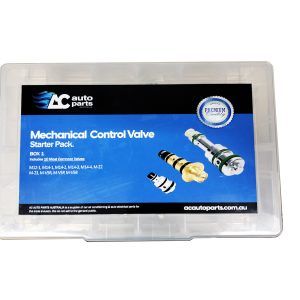Introduction
In modern automotive air conditioning systems, the Electronic Control Valve (ECV) plays a pivotal role in maintaining the efficiency and functionality of the compressor. For many technicians, issues with air conditioning systems are often attributed to the compressor itself, leading to expensive repairs or complete replacement. However, in many cases, the problem could be as simple as a faulty ECV.
Understanding how the ECV works, its function, and its common failures can save technicians and their customers significant costs.
This guide will provide an in-depth look at Electronic Control Valves, their role in air conditioning systems, troubleshooting techniques, and how replacing a malfunctioning ECV can be more profitable for technicians while being cost-effective for customers.
The Function of the ECV in Air Conditioning Compressors
What Does the ECV Do?
The ECV regulates the flow of refrigerant within the air conditioning compressor.
It works by adjusting the displacement of the variable displacement compressor, which directly impacts the cooling performance of the system.
Instead of allowing the compressor to run at full capacity all the time, the ECV controls how much refrigerant is compressed, making the system more efficient by reducing unnecessary energy usage.

Key Functions of the ECV:
- Refrigerant Flow Control: The ECV ensures the correct amount of refrigerant is pumped through the system.
- Compressor Regulation: By adjusting the internal displacement of the compressor, it allows for variable cooling performance.
- Fuel Efficiency: Because the ECV reduces the load on the compressor, it improves the vehicle's fuel efficiency.
Common Misdiagnosis: Compressor vs. ECV
Many technicians often default to diagnosing the compressor as the root of air conditioning failures. While compressors can fail, a faulty ECV is frequently the real issue. Misdiagnosing the problem can lead to unnecessarily replacing the compressor, which is both costly and time-consuming for the technician and the customer.
Symptoms of a Faulty ECV:
- Inconsistent cooling performance.
- Compressor cycling on and off too frequently.
- Insufficient cold air from the vents, despite a full refrigerant charge.
- Noisy operation of the air conditioning system.
Sell one of these packages and you've paid for the whole starter box!
Why Replacing the ECV is Cost-Effective
1. Lower Cost for Customers:
Instead of replacing an entire compressor, which can be expensive and labor-intensive, replacing just the ECV offers a much cheaper alternative.
This not only saves the customer money but also retains their trust in the technician's expertise and honesty.
2. Increased Profit Margins for Technicians:
Since the ECV is a smaller component, the part cost is significantly lower, but the labor involved in diagnosing and replacing it remains valuable. For technicians, this means higher margins on jobs that focus on replacing the ECV over replacing an entire compressor.
Additionally, recommending ECV replacements when necessary builds trust and can lead to long-term client relationships.
How to Diagnose ECV Failures
Understanding the specific signs of ECV failure is key to correct diagnosis. Here’s a step-by-step guide to diagnosing ECV problems:
Basic System Check
Before diving into ECV diagnostics, ensure that the refrigerant levels in the system are correct and that there are no visible leaks. Mismanagement of refrigerant levels can mimic ECV failure symptoms.
Monitor Compressor Operation
If the compressor is cycling on and off too quickly, or if there’s a lack of consistent cooling, the ECV may not be regulating the refrigerant properly.
Electrical Diagnostics
Using a multimeter, check for power and signal to the ECV. Ensure that the valve is receiving the correct signals from the vehicle’s air conditioning control module.
Mechanical Inspection
Remove the ECV and check for physical signs of wear, debris, or sticking, which can prevent proper operation. This step often uncovers simple mechanical issues that can be resolved with a replacement.
Conclusion: The Value of Knowing Your ECV
By understanding the importance of the Electronic Control Valve in air conditioning systems, technicians can offer more accurate diagnostics, save customers unnecessary expenses, and increase their own profitability. ECV replacement, when applicable, offers a cost-effective solution without compromising the system’s long-term reliability.
For trade customers, staying updated on developments in vehicle air conditioning technology and components like ECVs ensures they are offering the most efficient and cost-effective services to their clients.
Investing time in learning how to diagnose and replace the ECV not only sets technicians apart in a competitive industry but also fosters trust with customers who appreciate the more affordable and sustainable solutions.
Sell one of these packages and you've paid for the whole starter box!





